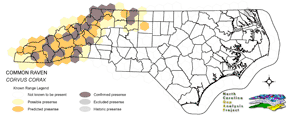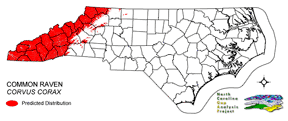
| Taxa: |
| Order: |
| Family: |
| Aves |
| Passeriformes |
| Corvidae |
| NatureServe Global Rank: |
| NatureServe State (NC) Rank: |
| G5 |
| S3 |
| Federal Status: |
| NC State Status: |
| --- |
| SR |


| Land Unit |
| US Fish & Wildlife Service |
| US Forest Service |
| US National Park Service |
| US Department of Defense |
| NC State Parks |
| NC University System |
| NC Wildlife Res. Com. |
| NC Forest Service |
| NC Div. of Coastal Mgmt. |
| Local Governments |
| Non-Governmental Org. |
| Other Public Lands |
| Private Lands |
| GAP Status 1-2 |
| All Protected Lands |
| Statewide |
| Hectares |
| 0.00 |
| 401,230.71 |
| 116.64 |
| 129,263.04 |
| 15,476.04 |
| 87.57 |
| 15,030.27 |
| 3,158.46 |
| 0.00 |
| 7,387.56 |
| 7,307.19 |
| 172.44 |
| 1,332,805.32 |
| 197,573.94 |
| 578,499.03 |
| 1,912,035.24 |
| Acres |
| 0.00 |
| 991,462.48 |
| 288.22 |
| 319,415.87 |
| 38,242.12 |
| 216.39 |
| 37,140.60 |
| 10,963.62 |
| 0.00 |
| 18,255.05 |
| 18,056.46 |
| 426.11 |
| 3,293,433.03 |
| 491,374.64 |
| 1,432,660.85 |
| 4,727,899.95 |
| % of Dist. on |
| Prot. Lands |
| 0.0 % |
| 69.4 % |
| 0.0 % |
| 22.3 % |
| 2.7 % |
| < 0.1 % |
| 2.6 % |
| 0.5 % |
| 0.0 % |
| 1.2 % |
| 1.2 % |
| < 0.1 % |
| 0.0 % |
| 34.2 % |
| ----- |
| ----- |
| % of Dist. on |
| All Lands |
| 0.0 % |
| 21.0 % |
| < 0.1 % |
| 6.8 % |
| 0.8 % |
| < 0.1 % |
| 0.8 % |
| 0.2 % |
| 0.0 % |
| 0.4 % |
| 0.4 % |
| < 0.1 % |
| 69.7 % |
| 10.3 % |
| ----- |
| ----- |
|
Found in the higher mountain, usually above 3,000 ft. (Simpson 1992). Breeds in mountainous areas where cliffs or rocky craggs are present for nesting (Hamel 1992, Simpson 1992). Hamel (1992) lists 'open woods, margins, and fields at high elevation,' as well as 'campgounds, picnic areas, dumps, and other places where garbage is left,' as frequent foraging locations. Nests are often in coniferous trees or on cliff ledges (Harrison 1975, Hamel 1992, Potter et al 1980). Generally it is constructed of sticks, twigs, and thickly lined with moss, wool, hair, grasses, bark shreds (Harrison 1975, Potter et al 1980). The omnivorous raven forages mostly on the ground (Goodwin1976, Hamel 1992, Kaufman 1996, Potter et al 1980). Large numbers may gather at communal roosts in trees or on cliff ledges (Goodwin1976). NATURE SERVE GLOBAL HABITAT COMMENTS: Various situations from lowlands to mountains, open country to forested regions, and humids regions to desert; most frequently in hilly or mountainous areas, especially in vicinity of cliffs (AOU 1983). Closely associated with humans along Beaufort Sea coast of Alaska (Johnson and Herter 1989). Nests usually on cliff ledges or in coniferous trees, also on man-made structures. See White and Tanner-White (1988) for information on the use of highway overpasses and billboards for nesting in Idaho and Utah. Often reuses nests in successive years. |
| Code | Name | Description | NC Natural Heritage Program Equivalent |
| 46 | Xeric Oak - Pine Forests | Mixed forest dominated by yellow pines with white or northern red oaks co-dominating. | Pine Oak Heath |
| 232 | Xeric Pine-Hardwood Woodlands and Forests | Mixed forest dominated by yellow pines with drier oaks including southern red, post, and chestnut oaks. | Dry Oak Hickory Forest |
| 228 | Piedmont Dry-Mesic Oak and Hardwood Forests | Primarily oak dominated forests, white oak is often dominant, with co-dominants including . Also represented by sweetgum and tulip poplar dominated forests. | Dry Mesic Oak Hickory Forest, Basic Oak Hickory Forest, Dry Oak Hickory Forest |
| 222 | Piedmont Dry-Mesic Pine Forests | Loblolly dominated forests resulting from succession following clearing. This type occurs on all moisture regimes following disturbance with the exception of the extremely xeric sites. | No equivalent |
| 382 | Dry Mesic Oak Pine Forests | Mixed forests of the coastal plain and piedmont. Includes loblolly pine with white, southern red and/or post oak and loblolly with water oak. On basic sites of the piedmont, eastern red cedar may co-occur with post, black, and blackjack oaks. | Dry Mesic Oak Hickory Forest, Xeric Hard Pan Forest, Chestnut Oak Forest, Dry Mesic Oak Hickory Forest, Dry Oak Hickory Forest |
| 220 | Piedmont Xeric Pine Forests | Dry to xeric pine forests dominated by Virginia pine, shortleaf pine or Eastern Red Cedar. | Pine Oak Heath |
| 226 | Piedmont Xeric Woodlands | Generally post and blackjack oak dominated woodlands. White ash and pignut hickory can be found in combination with Eastern red cedar on glades. | Xeric Hardpan Forest |
| 20 | Coniferous Regeneration | Regenerating pine stands. Predominantly loblolly pine, but slash and longleaf stands occur as well. | No equivalent |
| 36 | Successional Deciduous Forests | Regenerating deciduous trees with a shrub stature. Commonly dominated by sweetgum, tulip poplars and maples. | No equivalent |
| 180 | Agricultural Crop Fields | Farm fields used for row crops. | No equivalent |
| 205 | Agricultural Pasture/Hay and Natural Herbaceous | Farm fields used for pasture grass or hay production, as well as old fields dominated by native and exotic grasses. | No equivalent |
| 213 | Barren; quarries, strip mines, and gravel pits | Quarries, strip mines, or gravel pits. | No equivalent |
| 214 | Barren; bare rock and sand | Areas of bare rock, sand or clay. | No equivalent |
| 202 | Residential Urban | Includes vegetation interspersed in residential areas. Includes lawns, mixed species woodlots, and horticultural shrubs. Vegetation accounts for between 20 - 70% of the cover. | No equivalent |
| 203 | Urban Low-Intensity Developed | Highly developed areas with vegetation accounting for < 20% of the cover. | No equivalent |
| 521 | Spruce/Fir Forest | High Elevation Frazer-Fir - Red Spruce, Red Spruce and Red-Spruce-Yellow Birch Forests. Tree densities included here include both woodland to forest density. Highly intermixed with Northern Hardwoods, Grassy Balds, and Shrub Balds. | Red Spruce--Fraser Fir Forest, Fraser Fir Forest |
| 522 | Northern Hardwoods | High Elevation forests including yellow birch, American beech, and yellow buckeye. Includes forests with Hemlock and Yellow Birch. | Northern Hardwoods Forest, Boulderfield Forest |
| 523 | Grassy Bald | High Elevation grassy balds including Pennsylvania sedge, mountain oatgrass, as well as shrubby areas dominated by Alleghany and smooth blackberry. | Grassy Bald |
| 524 | Shrub Bald | Variable phenologies, predominantly evergreen balds with rhododendon and Mountain laurels. Deciduous shrubs including green alder and Alleghany and smooth blackberry are included as well. Red Oak - Chestnut Oak Woodlands may be included in cases where the density of the woodland species is low and the shrub component is dense. | Heath Bald |
| 525 | Appalachian Oak Forest | A variety of oak forest types including Black, White, Scarlet Oaks in dry to mesic situations. Includes forests historically co-dominated by American Chestnut. | High Elevation Red Oak Forest, Montane White Oak Forest |
| 526 | Appalachian Cove Forest | Mixed Mesophytic forests of the mountains. Includes tuliptree, basswood, yellow buckeye and surgar maple. This class is mapped to include cove forests dominated or co-dominated by hemlock. | Rich Cove Forest, Acidic Cove Forest |
| 527 | Appalachian Hemlock | Upland hemlock forests of the moutains region. Vary from side slopes to steep slope positions. | Canada Hemlock Forest |
| 528 | Appalachian Xeric Pine Forest | Pine forests and woodlands on xeric sites. A variety of pines, including Virginia, Shortleaf, Eastern White Pine, Table Mountain and Pitch pine. Often small areas of dense pine within a matrix of Xeric Oak-Pine Forests. | Pine Oak Heath |
| 529 | Appalachian Xeric Mixed Forest | Mixed forests with Virginia, Shortleaf, Eastern White Pine, Table Mountain and Pitch pines in combination with xeric oak species. Oaks include, white, Southern Red, black, and rock chestnut. | Pine Oak Heath |
| 530 | Appalachian Xeric Deciduous Forest | Deciduous forests in the mountains dominated by Xeric Oak species. Species include, white, Southern red, black, and rock chestnut. | High Elevation Red Oak Forest, Montane White Oak Forest |
| 533 | Appalachian Swamp Forest | Evergreen and deciduous forests with saturated hydrologies. This class may contain a variety of trees species, including hemlock - red maple, pitch pine, and white pine forests. | Swamp Forest-Bog Complex, Southern Appalachian Bog, Southern Appalachian Fen |
| 534 | Appalachian Wet Shrubland/ Herbaceous | Saturated shrubs and herbaceous vegetation. Often mapped as an inclusion in Appalachian Swamp Forest. | Southern Appalachian Bog, Southern Appalachian Fen |
| 535 | Talus/Outcrops/Cliffs | Includes seep talus slopes with sparce vegetation, as well as outcrops including, granitic outcrops. Some outcrops will have been mapped as barren rock. | No equivalent |
|
Flanagan, T. J. 1993. Recolonization of the common raven in Berkshire County, Massachusetts. Bird Observer 21(4):197-204.
Bent, A.C. 1946. Life histories of North American jays, crows, and titmice. U.S. Natl. Mus. Bull. 191. Washington, D.C. Hamel, P. B. 1992. The land manager's guide to the birds of the south. The Nature Conservancy, Chapel Hill, North Carolina. 367 pp + several appendices. Simpson MB Jr. 1992. Birds of the Blue Ridge Mountains. Chapel Hill and London: University of North Carolina Press. Linz, G. M., C. E. Knittle, and R. E. Johnson. 1992. Home range of breeding common ravens in coastal southern California. Southwest. Nat. 37:199-202. White, C. M., and M. Tanner-White. 1988. Use of interstate highways overpasses and billboards for nesting by the common raven (CORVUS CORAX). Great Basin Nat. 48:64-67. Harrison, H.H. 1975. A field guide to bird's nests in the U.S. east of the Mississippi River. Houghton Mifflin Company, Boston, Massachusetts. 257 p. Harrison, C. 1978. A field guide to the nests, eggs and nestlings of North American birds. Collins, Cleveland, Ohio. Harrison, H.H. 1979. A field guide to western birds' nests. Houghton Mifflin Company, Boston. 279 pp. Potter, E. F., J. F. Parnell, and R. P. Teulings. 1980. Birds of the Carolinas. Univ. North Carolina Press, Chapel Hill. 408 pp. Terres, J.K. 1980. The Audubon Society encyclopedia of North American birds. Alfred A. Knopf, New York. American Ornithologists' Union (AOU), Committee on Classification and Nomenclature. 1983. Check-list of North American Birds. Sixth Edition. American Ornithologists' Union, Allen Press, Inc., Lawrence, Kansas. Goodwin, D. 1986. Crows of the world. Second edition. Univ. Washington Press. 300 pp. Heinrich, B. 1989. Ravens in winter. Summit Books, New York. 379 pp. Johnson, S.R., and D.R. Herter. 1989. The birds of the Beaufort Sea. BP Exploration (Alaska) Inc., Anchorage, Alaska. 372 pp. Kilham, L. 1989. The American crow and the common raven. Texas A & M Univ. Press. 272 pp. Droege, S., and J.R. Sauer. 1990. North American Breeding Bird Survey, annual summary, 1989. U.S. Fish and Wildlife Service, Biological Report 90(8). 22 pp. Goodwin, L.M. 1976. Environmental Assessment of Proposed Service Area Project. |
For more information please contact them at:
NC-GAP Analysis Project
Dept. of Zoology, NCSU
Campus Box 7617
Raleigh, NC 27695-7617
(919) 513-2853
www.basic.ncsu.edu/ncgap